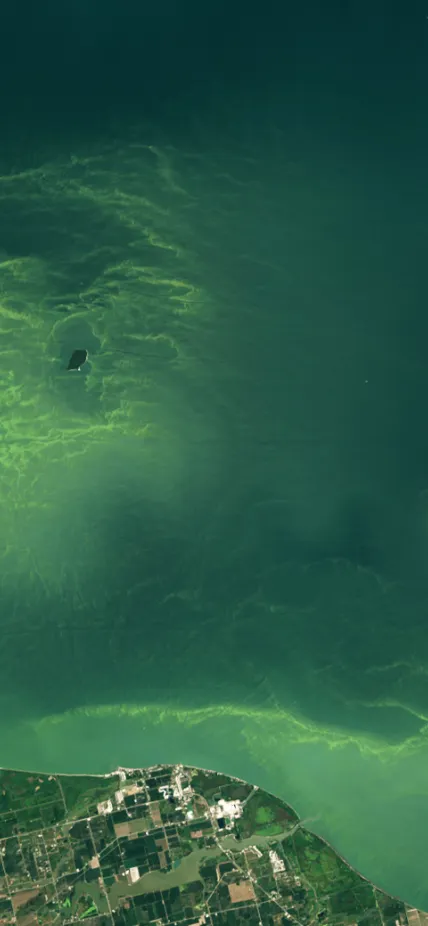Washington, DC—Recommended limits on the flow of nutrients into Lake Erie from agriculture may be too restrictive for some species of fish. They are, however, suited to maintain healthy fisheries until the middle of this century amid a warming climate, according to a new study published in Proceedings of the National Academy of Sciences.
The paper builds on work from Carnegie Science’s Anna Michalak, whose research team—including three alumni co-authors on the paper Dan Obenour, Yuntao Zhao and Gang Zhao—has spent more than a decade elucidating the intersection of climate change and water quality issues.
"Hitting the target for the future is the right thing to do now," said the University of Michigan’s Don Scavia, who headed up the research effort. "Even though the proposed limits are too much for now, I don't think they should be relaxed because it takes a decade or longer to affect change."
In the project, the team linked forward-looking climate projections and nearly a century of fishery data with a mathematical model of Lake Erie's nutrient load and a water quality indicator—namely, the oxygen available in the lake's depths.
With all these factors considered, the researchers showed that the relationships aren't as straightforward as the casual observer might expect. There are tradeoffs. For example, while cutting back on nutrients does improve water quality, that doesn't necessarily benefit all fish.
And, moving forward, warming temperatures—rather than nutrient load—will become the dominant influence over the oxygen in Lake Erie and similar ecosystems around the world.
Taken altogether, this means that there's no simple solution to managing these ecosystems. And the solutions rolled out today will need to be continuously evaluated and reassessed in the future. In the land management world, this is what's called a "wicked problem."
Fortunately, the team's research provides key insights on how to approach those.
The nutrients in fertilizers that farmers use to feed plants also feed aquatic microorganisms like algae and cyanobacteria. Nutrient-rich runoff water from fields helps fuel the infamous algal blooms in Lake Erie—as well as, for example, in the northern Gulf of Mexico and Chesapeake Bay.
When the algae and cyanobacteria in those blooms die, they sink to the bottom of the water and decompose, consuming enough oxygen in the process to render the water hypoxic. Even underwater, oxygen is essential for life and so hypoxic bottom water regions are often referred to as "dead zones."
Hypoxia is bad news for lake whitefish that prefer the cold bottom water of Lake Erie. But, while the cyanobacteria in algal blooms thrive in fertile, nutrient-rich waters, so too do the plankton that feed the lake's larger fish. And not all of those fish live at depths where hypoxia is a problem. Yellow perch, for instance, actually benefit from water that's richer in nutrients.
At present, the level of nutrient inputs is beneficial to yellow perch and walleye but limiting bottom habitat for whitefish. Finding the right balance between fishery and water quality considerations is a delicate and ever-moving target, complicated by the fact that the lake's microbes proliferate faster in warmer temperatures.
"I don't want to see my research being used to say we should pollute to keep the fisheries highly productive," said co-author Stuart Ludsin of Ohio State University. "If there's no effort to curtail this hypoxia and water quality problem, with continued climate change, the lake will not be able to support vital fish."
The real message, he said, is more nuanced. It’s about finding the right level of nutrients to meet water quality goals while still supporting fisheries.
And what is "right" should be determined by a water system's managers and stakeholders coming together, said Anna Michalak, who is founding director of Carnegie Science's Climate and Resilience Hub. By bringing data and tools like the team's model into those discussions, all parties can understand how the best choices for, say, water quality may come at a cost to fisheries, and vice versa.
"The number one takeaway is the importance of approaching these management issues with systems-level thinking. What I mean by that is that there are always going to be tradeoffs depending on what your specific objectives are," said Michalak.
"We can't be playing whack-a-mole when it comes to environmental systems. It's only by thinking about them holistically that we can come up with solutions that work."
Although the data and decisions will look different for different ecosystems, this approach is generalizable, the team said.
"I think that this study provides a template and prior knowledge that can be applied to other systems," said Dan Obenour, of North Carolina State University, who earned his doctorate under the mentorship of Scavia and Michalak.
The study also highlighted that the team's climate-hypoxia model is robust and reliable over long time periods. Combined with the fact that it was designed to be "embarrassingly simple," Michalak said, the model is equipped to be an asset in informing best practices into the future.
"This is a wicked problem," Obenour said. "It's challenging to determine what the best management solution is and, even if you reach a consensus, it's going to change in the future. We need to stay on our toes."
Also contributing to the project were researchers from Heidelberg University in Ohio, Shanghai Jiao Tong University and the Chinese Academy of Sciences.
